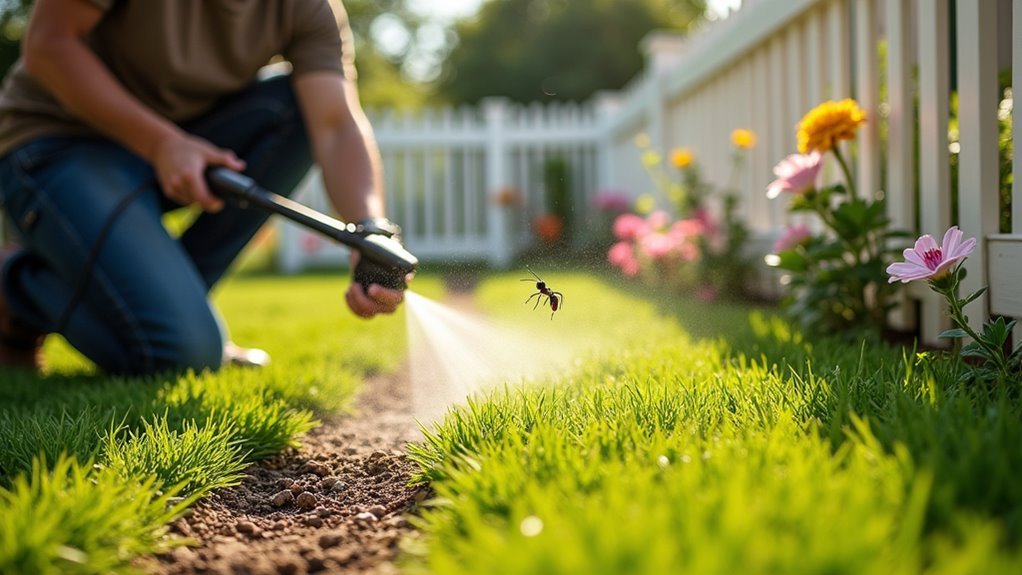You’ll achieve the best perimeter pest control by timing treatments to seasonal migration patterns. Apply barrier treatments in early spring before ant colonies establish routes, then schedule professional treatments every 3-4 months during summer’s peak activity. Fall requires sealing exterior cracks and removing debris that attracts indoor-seeking rodents and spiders. Winter focuses on monitoring and maintaining sealed entry points. Climate change now extends breeding seasons, requiring year-round vigilance and earlier preventive measures for ideal protection.
Understanding Seasonal Pest Cycles and Migration Patterns

As temperatures shift throughout the year, different pests emerge and retreat in predictable patterns that can help you stay one step ahead of infestations. Understanding seasonal pest cycles is essential for effective perimeter treatments.
Spring’s warming temperatures awaken overwintering ants and termites, while summer heat intensifies mosquito and fly activity. Fall triggers rodents and spiders to seek indoor shelter, making this season vital for sealing entry points.
Winter demands preventative measures against cold-weather pests.
Climate change has disrupted traditional cycles, extending breeding seasons and altering migration patterns. You’ll need to adapt your pest control strategies accordingly.
A proactive approach tailored to each season’s specific threats greatly reduces infestation risks. By monitoring pest activity patterns and implementing targeted treatments, you’ll maintain effective year-round protection.
Spring Perimeter Treatments for Emerging Insect Populations
Spring’s arrival signals the perfect time to implement targeted perimeter treatments that stop emerging insect populations before they establish footholds around your home.
Early spring perimeter treatments create protective barriers that prevent insects from establishing colonies around your property before infestations take hold.
As overwintering insects like ants, cockroaches, and spiders become active, you’ll need effective pest prevention strategies to prevent infestations.
Deploy these essential spring perimeter pest control measures:
- Apply protective barriers around your foundation, door frames, and windows using targeted treatments.
- Conduct thorough inspections to identify entry points, seal cracks, and eliminate standing water that attracts outdoor pests.
- Plant natural deterrents like lavender and marigolds around your perimeter to repel insects organically.
- Time treatments early in spring to create invisible barriers before pests establish breeding grounds.
These proactive measures greatly reduce your risk of dealing with established pest populations later.
Targeting Ant Colonies Before They Establish Summer Routes

You’ll need to spot ant activity early in spring when colonies first emerge from winter dormancy and begin establishing their foraging patterns.
Focus your detection efforts on identifying ant trails, entry points around your foundation, and small mounds of displaced soil that signal nearby nesting sites.
Time your perimeter barrier applications for late winter or early spring, applying insecticides around door frames, window sills, and foundation edges before ants can map out their summer routes to your home.
Early Colony Detection Methods
Why wait until ant colonies establish their summer highways when you can intercept them during their vulnerable early stages?
Early colony detection gives you the upper hand in preventing major infestations before ants expand their territory.
Here’s how to spot and eliminate colonies early:
- Inspect for ant activity during early spring – look for trails, small nests, and individual foraging ants around your home’s perimeter.
- Deploy strategic bait stations around your property’s edges to attract and eliminate worker ants before they establish indoor routes.
- Monitor moisture levels and fix drainage issues, as damp areas attract nesting colonies.
- Apply barrier treatments around your foundation in early spring to create protective zones.
This proactive pest control treatment approach prevents pests from gaining footholds near your home.
Perimeter Barrier Application Timing
Once you’ve identified potential colony sites through early detection, timing your perimeter barrier application becomes the difference between prevention and playing catch-up all summer.
Apply treatments in late winter or early spring before ants emerge and establish foraging routes. This timing disrupts colonies while they’re still dormant, creating an invisible shield around your home’s foundation.
Target all potential entry points during this critical window—cracks, gaps, and areas where utilities enter your home.
As temperatures rise and ant activity increases, your barrier will already be in place. Don’t wait until you see trails; by then, colonies have organized their summer strategy.
Reapply every 3-4 months to maintain effectiveness throughout the active season.
Early Season Moisture Control and Foundation Sealing
You’ll want to conduct a thorough spring foundation inspection to identify potential entry points and moisture issues before pests establish their seasonal patterns.
Start by walking your home’s perimeter to check for cracks larger than 1/4 inch, damaged caulking, and any signs of water accumulation near the foundation.
Focus on eliminating moisture sources like leaky gutters, standing water in planters, and poor drainage areas that create the damp conditions pests need to thrive.
Spring Foundation Inspection
As temperatures begin to rise and insects emerge from winter dormancy, conducting an extensive foundation inspection becomes your first line of defense against spring pest invasions.
This preventive measure helps you identify vulnerabilities before they become major problems.
Your spring pest control foundation inspection should include these critical steps:
- Examine all foundation walls for cracks larger than 1/4 inch that serve as pest entry points.
- Check moisture control systems including gutters, downspouts, and drainage around your home’s perimeter.
- Inspect landscaping areas near the foundation for debris and overgrown vegetation that provides pest shelter.
- Test sealing cracks from previous repairs to verify they remain intact after winter weather.
Regular foundation inspection during spring catches potential issues early, preventing costly infestations as warmer weather attracts mosquitoes, termites, and other pests.
Moisture Source Elimination
After completing your foundation inspection, eliminating moisture sources becomes your next critical step in creating an unwelcoming environment for spring pests. Address drainage issues and standing water immediately, as these attract mosquitoes and termites. Seal gaps and cracks in your foundation to reduce moisture accumulation and eliminate pest entry points.
| Moisture Control Method | Target Area | Pest Prevention Benefit |
|---|---|---|
| Fix leaks and drainage | Exterior perimeter | Eliminates mosquito breeding sites |
| Seal foundation cracks | Foundation walls | Blocks termite entry points |
| Install dehumidifiers | Indoor spaces | Controls cockroach habitats |
| Grade soil away | Home foundation | Improves water drainage |
Maintain humidity levels below 50% indoors using dehumidifiers. These preventative treatments create inhospitable conditions for moisture-loving pests like cockroaches while preventing mold growth throughout your home’s perimeter.
Summer Heat-Driven Pest Management Along Property Lines

When summer temperatures soar, pest activity escalates dramatically around your property’s perimeter, with mosquitoes, flies, and other insects becoming increasingly aggressive in their search for food, water, and shelter.
Summer heat intensifies these outdoor pests, making effective perimeter pest control essential for maintaining a protective barrier around your home.
To combat heat-driven pest invasions, implement these strategic measures:
- Plant natural deterrents like lavender and marigolds along property lines to repel insects naturally.
- Position trash bins away from entry points and empty them regularly to reduce pest attraction.
- Maintain landscape hygiene by mowing grass and trimming bushes to eliminate pest habitats.
- Schedule professional treatments every 3-4 months during summer to maintain an effective perimeter barrier.
These proactive steps will greatly reduce pest pressure around your home’s exterior.
Creating Defensive Plant Barriers Around Home Perimeters
While chemical treatments provide immediate pest control, establishing strategic plant barriers around your home’s perimeter offers a sustainable, eco-friendly defense system that works around the clock.
You’ll create effective defensive plant barriers by planting lavender, marigolds, and citronella around entry points to repel pests like mosquitoes and flies naturally.
Incorporate culinary herbs such as basil and mint near doorways—they’ll enhance your cooking while deterring aphids and spiders.
Rosemary and lemongrass add mosquito-repelling power through their strong scents.
This barrier around your home addresses unique pest challenges while encouraging beneficial insects like ladybugs that prey on harmful pests.
Regular maintenance including pruning and plant replacement guarantees your natural defense system remains effective year-round.
Managing Flying Insect Populations During Peak Activity Months
You’ll face the highest flying insect activity during summer months when mosquitoes and flies reach their peak populations.
Your perimeter treatment strategy must intensify during these warmer periods, requiring monthly inspections and targeted interventions around your property’s boundaries.
You can’t rely on passive measures alone—active treatment methods become essential for maintaining control when these pests are most aggressive.
Peak Activity Timing
As summer temperatures climb and humidity levels soar, flying insect populations like mosquitoes and flies reach their seasonal peak. This makes this the most critical time for implementing your perimeter pest control strategy. Understanding peak activity timing helps you coordinate with pest control services for maximum effectiveness during warmer weather.
Proactive measures become essential when flying insects are most active:
- Schedule treatments in late spring before populations explode to establish protective barriers around your property perimeter.
- Target peak breeding months (June through August) when humidity creates ideal reproduction conditions.
- Eliminate standing water sources like clogged gutters and bird baths where mosquitoes multiply rapidly.
- Plan regular inspections every 4-6 weeks during summer months to maintain consistent protection levels.
Strategic timing prevents infestations rather than reacting to existing problems.
Perimeter Treatment Methods
Once you’ve identified peak activity timing, selecting the right perimeter treatment method becomes essential for establishing an effective defense system around your home.
Professional pest control services focus on creating a protective barrier by targeting critical entry points including windows, doors, and eaves where flying insects typically infiltrate your property.
Seasonal treatments incorporate insect growth regulators that disrupt mosquito breeding cycles, greatly reducing populations over time.
You’ll need reapplication every 3-4 months to maintain barrier effectiveness throughout peak activity periods.
When choosing perimeter pest treatments, consider eco-friendly products that minimize harm to beneficial insects while effectively managing nuisance populations.
These targeted approaches allow you to control mosquitoes, flies, and wasps without compromising your local ecosystem’s balance.
Fall Exclusion Techniques to Prevent Winter Invasions
When temperatures begin to drop, pests actively search for warm shelter, making your home an attractive target for winter invasions. Effective fall exclusion techniques focus on sealing entry points and eliminating pest-friendly conditions around your property.
Your pest control strategy should include these essential steps:
- Seal exterior cracks – Use steel wool or caulk on gaps larger than 1/4 inch to block rodents and spiders.
- Remove debris – Clear leaf piles, woodpiles, and other materials from your foundation that provide nesting spots.
- Trim overhanging branches – Cut back tree limbs touching your roof to reduce potential pest entry routes.
- Inspect weather stripping – Check and repair door and window seals regularly.
Regular yard maintenance, including gutter cleaning and proper drainage, can reduce winter pest invasions by up to 70%.
Sealing Entry Points Before Rodent Migration Season
You’ll need to identify and seal critical entry points around your home’s foundation, windows, doors, and utility penetrations before rodents begin their seasonal migration indoors.
Steel wool, caulk, and other durable materials provide effective barriers when applied correctly to gaps as small as 1/4 inch for mice and quarter-sized openings for rats.
Timing this work during late summer or early fall—before temperatures drop—gives you the best chance to prevent up to 70% of potential winter rodent invasions.
Critical Entry Point Locations
Three primary areas around your home serve as highways for rodents seeking winter shelter: utility penetrations, foundation vulnerabilities, and door-window interfaces.
These critical entry points require immediate attention before rodent migration intensifies during fall months.
Focus your sealing entry points efforts on these locations:
- Utility line penetrations – Seal gaps around pipes, cables, and vents with steel wool or caulk
- Foundation cracks larger than 1/4 inch that provide direct basement access
- Gaps around windows and door frames where weatherstripping has deteriorated
- Landscaping contact points where overgrown shrubs create bridges to your home’s exterior
Regular inspections of these vulnerable zones help identify problems early.
Even tiny openings can accommodate mice, so thorough sealing prevents indoor infestations and maintains healthier winter living conditions.
Effective Sealing Materials Methods
Choosing the right sealing materials makes the difference between temporary fixes and long-lasting rodent barriers. You’ll need steel wool or high-quality caulk for gaps larger than 1/4 inch, since rodents squeeze through surprisingly small openings.
These effective sealing materials create impenetrable barriers when applied to foundation cracks and crevices around your home’s perimeter.
Focus your efforts on utility entry points, windows, and door frames where rodents commonly infiltrate. Weather stripping proves essential for doors and windows, preventing access during colder months when these pests seek indoor shelter.
Regular inspections guarantee your sealing efforts remain intact throughout migration season.
Support your pest prevention strategy by maintaining clutter-free outdoor areas, eliminating nesting materials and hiding spots that attract rodents near sealed entry points.
Optimal Timing Strategies
Since rodents begin their seasonal migration as temperatures drop, timing your sealing efforts for late summer dramatically improves your home’s defense against winter infestations.
Strategic pest control timing can reduce rodent problems by up to 70% when you seal entry points before migration season begins.
Your seasonal home perimeter defense strategy should include:
- Late summer inspections – Conduct thorough examinations of your foundation, utility connections, and windows to identify vulnerabilities before rodents seek shelter.
- Focus on quarter-inch gaps – Seal cracks and openings larger than 1/4 inch around your home’s perimeter using steel wool or caulk.
- Yard maintenance – Remove debris and clutter that attracts nesting rodents near your property.
- Material selection – Choose durable sealing materials that rodents can’t gnaw through, avoiding plastic or rubber options.
Pre-Winter Perimeter Inspections and Barrier Maintenance
Although winter may seem like a time when pest activity decreases, many insects and rodents actually become more aggressive in their search for warm shelter as temperatures drop.
Your pre-winter perimeter inspections should focus on identifying vulnerabilities before cold weather forces pests indoors. Examine your home’s foundation, windows, and doors for cracks and gaps that provide easy access points.
Replace worn weather stripping around doors and windows to create tight seals that eliminate pest entry routes. Clear debris, fallen leaves, and wood piles from your yard to remove potential nesting sites.
Apply barrier treatment around your home’s exterior, concentrating on vulnerable areas like entry points and foundation gaps. Schedule these tasks in late fall to proactively address weaknesses before winter arrives.
Winter Dormant Season Treatments and Monitoring
While winter’s cold drives most outdoor pests into dormancy, this season presents your best opportunity to implement strategic treatments and establish monitoring systems that’ll protect your home through spring’s pest resurgence.
Winter’s your prime time to prevent pests from establishing footholds in your home. Focus on these essential dormant season strategies:
- Seal exterior gaps and cracks – Inspect your home’s foundation, siding, and roofline for openings where pests seek warmth.
- Monitor for pest activity signs – Check for droppings, gnaw marks, and tracks around potential shelter areas.
- Secure all entry points – Verify weather stripping around windows and doors remains intact and functional.
- Maintain firewood distance – Store wood at least 20 feet from your home to avoid introducing termites and rodents.
Regular monitoring during winter prevents small problems from becoming spring infestations.
Year-Round Perimeter Treatment Scheduling and Timing
Four strategic treatment windows throughout the year create an impenetrable barrier that keeps pests from establishing territories around your home.
Year-round perimeter treatments every 3-4 months maintain continuous protection against evolving threats. You’ll want to start with preventive perimeter treatments in February, creating your barrier before spring awakens dormant pests.
A quarterly treatment routine aligns perfectly with seasonal pest activity peaks. Spring brings ants and termites, while fall triggers rodent invasions.
Timely treatments address these specific threats before they escalate into full infestations. You should schedule regular inspections alongside each treatment to monitor for new vulnerabilities and guarantee your barrier remains effective.
This proactive approach keeps you ahead of pest invasions by matching your defense strategy to natural pest behavior patterns.
Professional vs. DIY Seasonal Treatment Applications
When choosing between professional services and DIY applications for seasonal perimeter treatments, you’ll discover significant differences in effectiveness and long-term protection.
Professional services offer distinct advantages over DIY methods:
- Specialized Products: Professionals use commercial-grade treatments that create lasting barriers, while DIY methods rely on over-the-counter solutions with limited effectiveness.
- Expert Knowledge: Trained technicians identify structural vulnerabilities and understand pest behavior patterns that DIY approaches often miss.
- Optimal Timing: Professional perimeter pest control follows strategic scheduling—like February applications before spring pest activity—unlike poorly timed DIY treatments.
- Consistent Coverage: Regular professional treatments every 3-4 months address seasonal pest cycles systematically, while DIY methods lack the regularity needed for year-round protection.
Professional services also guarantee safe application practices, reducing risks from improper chemical handling.
Adapting Perimeter Strategies for Climate Change Effects
As climate change reshapes global weather patterns, you must fundamentally rethink your home’s perimeter pest control strategy to address evolving threats.
Extended breeding seasons now require year-round treatments rather than traditional seasonal applications. You’ll need to start preventive measures earlier since warmer temperatures activate pests like mosquitoes and ants sooner in spring.
Increased humidity creates ideal pest conditions, making it essential to seal entry points and manage moisture around your property.
Since seasonal pest patterns shift unpredictably, you should monitor local pest behavior data and adjust your perimeter strategies accordingly.
Focus on eco-friendly treatments that effectively combat climate-driven pest activity while protecting your family and pets.
These targeted approaches help you stay ahead of changing pest behaviors without compromising environmental safety or treatment effectiveness.
Frequently Asked Questions
Does Pest Control Work in the Winter?
Yes, pest control works in winter. You’ll prevent rodents and insects from entering your home as they seek warmth. Winter treatments create protective barriers and address vulnerabilities before spring pest activity increases considerably.
How Long Does Perimeter Spray Last?
Your perimeter spray typically lasts 60 to 90 days, depending on the product and weather conditions. You’ll need to reapply every 3-4 months to maintain effective pest protection throughout the seasons.
Does Spraying for Bugs Around the House Work?
Yes, spraying for bugs around your house works effectively. You’ll create an invisible barrier that kills insects on contact and prevents breeding. Studies show you can reduce pest invasions by up to 70%.
What Is the Best Season for Pest Control?
Spring’s your best bet for pest control since overwintering pests wake up then. You’ll want to start treatments in February to create barriers before they become active and cause infestations.
In Summary
You’ll achieve the best results by adapting your perimeter treatments to each season’s unique pest challenges. Start early with spring preventatives, maintain consistent summer barriers, and don’t skip winter monitoring. Whether you’re applying treatments yourself or hiring professionals, timing matters more than product selection. As climate patterns shift, you’ll need to adjust your seasonal approach accordingly. Consistent year-round vigilance keeps pests from establishing footholds around your property.





Leave a Reply